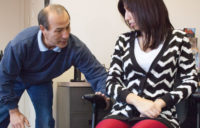Office safety: 25 steps to a safer office

Photo: Missouri Department of Transportation
KEY POINTS
- Falls are the most common source of injury in an office, although workers also are injured by being struck by or against objects, and suffering ergonomic injuries.
- Some simple changes to the workspace can be effective in eliminating hazards and reducing the number of injuries.
- Administrative interventions such as scheduled walk-throughs and the establishment of a formal reporting system can help protect workers in an office environment.
It's fairly obvious that safety and health hazards can exist on worksites filled with heavy machinery and equipment, where employees often are required to engage in strenuous manual labor.
A job where most of the work tasks are completed while sitting in a chair in a climate-controlled office building would seem less fraught with danger. However, a surprising number of hazards can be present in an office setting.
According to data from the Bureau of Labor Statistics, 80,410 private-industry office and administrative workers suffered on-the-job injuries in 2008. Many of these injuries could have been prevented had workers or supervisors recognized the risks and implemented simple workplace modifications to help mitigate them.
Here are 25 steps you can take to reduce the risk of injury among your office staff.
Falls
Slips, trips and falls, the most common type of office injury, sidelined 25,790 workers in 2008, according to BLS. Several hazards contribute to these injuries, although most can be significantly reduced, often by raising awareness among employees.
Stay clutter-free
Boxes, files and various items piled in walkways can create a tripping hazard, according to OSHA. Be certain that all materials are safely stored in their proper location to prevent buildup of clutter in walkways. Further, in addition to posing an electrical hazard, stretching cords across walkways or under rugs creates a tripping hazard, so ensure all cords are properly secured and covered.
Step on up
Standing on chairs – particularly rolling office chairs – is a significant fall hazard. Workers who need to reach something at an elevated height should use a stepladder. The Chicago-based American Ladder Institute cautions that stepladders must be fully opened and placed on level, firm ground. Workers should never climb higher than the step indicated as the highest safe standing level.
Maintain a clear line of vision
Workers can collide when making turns in the hallways and around blind corners or cubicle walls. The National Safety Council suggests installing convex mirrors at intersections to help reduce collisions. If workers can see who is coming around the corner, collisions are less likely to occur.
Get a grip
Carpeting and other skid-resistant surfaces can serve to reduce falls. Marble or tile can become very slippery – particularly when wet, according to the National Safety Council. Placing carpets down can be especially helpful at entranceways, where workers are likely to be coming in with shoes wet from rain or snow.
Struck/caught by
Another major type of injury in the office setting comes from workers being struck by or caught by an object. Incidents of this nature accounted for 15,680 injuries in 2008, according to BLS.
Shut the drawer
File cabinets with too many fully extended drawers could tip over if they are not secured, the council warns. Additionally, open drawers on desks and file cabinets pose a tripping hazard, so be sure to always completely close drawers when not in use.
Safe stacking
According to the Office of Compliance, which oversees the safety of U.S. congressional workers, proper storage of heavy items can help reduce the number of office injuries. Large stacks of materials and heavy equipment can cause major injuries if they are knocked over. OOC recommends storing heavy objects close to the floor, and warns that the load capacity of shelves or storage units should never be exceeded.
Ergonomics injuries
Perhaps the most prevalent injuries in an office setting are related to ergonomics. Because office workers spend the bulk of their day seated at a desk and working on a computer, they are prone to strains and other injuries related to posture and repetitive movement. Ergonomics hazards can be difficult to detect. “Most office conditions that can be described as hazardous from an ergonomics perspective would appear quite innocuous to the everyday observer,” said Marc Turina, principal consultant for ErgoSmart Consultants in McKees Rocks, PA.
Provide adjustable equipment
One size does not fit all in an office workstation. “Adjustability is the key,” Turina said. “Chairs, work surfaces, monitor stands, etc., should all be adjustable in order to accommodate the widest range of employees.” He recommended presenting a variety of options to employees. Although employers may be reluctant to pay for expensive ergonomic equipment, experts insist the equipment is a wise investment. “A good keyboard tray may retail around $300; a good chair may retail around $500 to $700,” said Sonia Paquette, professional ergonomist and doctor of occupational therapy. She points out that the cost of the health claims that stem from not having these devices is much higher. “Some of these hard claims cost many tens of thousands of dollars just of medical treatment, let alone cost of replacement, absenteeism, loss of work production, etc.”
Train workers on how to use equipment
Providing adjustable furniture and equipment is only the first step in creating an ergonomically sound workstation. “A big issue that I have encountered a lot lately is employee inability to properly adjust their own office chairs,” Turina said. “Many times, employers can invest $500 in an excellent adjustable chair, but employees still experience a bad workstation fit.” The problem often is twofold: Workers do not know how to adjust their equipment, and they do not know the most ergonomically beneficial way to set up their workstation. Train workers on both the ideal setup and how to operate adjustable equipment accordingly.
Keep your feet on the floor
One of the first questions Paquette asks workers is whether their feet touch the floor when seated at their desk. “It sounds like an incredibly simple question,” she said, “but very often workers have their keyboard tray on the desktop, so in order to reach it, they need to jack up their chair so high that their feet can barely touch the floor.” She added that unless an employee’s feet are on the floor, a chair will not be able to reduce pain and discomfort. She recommended options such as adjustable keyboard trays or rolling tables adjusted to the proper height to eliminate this problem. Although footrests are a “second-best option,” their small surface may impede some of the worker’s movement.
Provide document holders
Frequently typing from hard copy can lead to neck strain if a worker is forced to repeatedly look down to the desk and back to the computer screen. Turina recommends providing document holders to reduce this strain. “These document holders are reasonably priced, and eliminate excessive cervical motion and help to prevent muscle imbalances,” he said. Document holders also are good for the eyes, according to the St. Louis-based American Optometric Association. Keeping reference materials close to the monitor reduces the need for your eyes to change focus as you look from the document to the monitor.
Correct mouse placement
Paquette often sees workstations where the computer keyboard is on a tray, but the mouse remains on the desk. “That spells disaster for the neck and shoulder on the side of that mouse,” she said. She recommends that the mouse always be placed beside the keyboard.
 Also see Office worker ergonomics: An illustrated workstation assessment.
Also see Office worker ergonomics: An illustrated workstation assessment.
Post a comment to this article
Safety+Health welcomes comments that promote respectful dialogue. Please stay on topic. Comments that contain personal attacks, profanity or abusive language – or those aggressively promoting products or services – will be removed. We reserve the right to determine which comments violate our comment policy. (Anonymous comments are welcome; merely skip the “name” field in the comment box. An email address is required but will not be included with your comment.)

